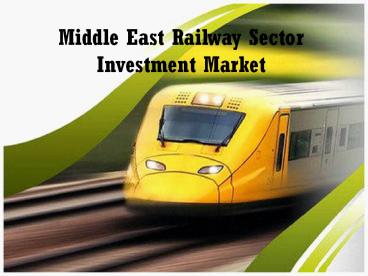Middle East Railway Sector Investment Market PowerPoint PPT Presentation
Title: Middle East Railway Sector Investment Market
1
Middle East Railway Sector Investment Market
2
Summary
Middle East Railway Sector Investment
Opportunity Analysis report gives comprehensive
insight on the current scenario of rail transport
in Middle East region at country level. Report
also discusses the policy and regulatory
framework adopted by each country along with the
initiatives undertaken by the various
stakeholders to promote the growth of rail
network in the region. Currently Iran, Turkey,
Egypt and Saudi Arabia are the dominant players
in the regional rail network expansion efforts.
The total rail network length in region is close
to 35,000 km and is further expected to surpass
45,000 km by 2030 years with total investment of
more than US 200 Billion.
3
Beginning of rail transport in Middle East dates
back to late nineteenth century when national
railway lines were constructed in Egypt, Turkey,
Iraq and Iran. After that during the Ottoman
Empire, railway network in Middle East grew
substantially in the countries like Saudi Arabia,
Jordan and Syria. Like most of the other parts in
Asia and Africa, railway construction in various
Middle East countries is also a history of the
colonial powers strategic and economic
priorities. During the first part of the 1900s,
railways were built for military purposes, as
well as to provide distribution routes for
products from the industries of the colonizing
nations and raw materials for the same
industries. Consequently, the lines have
different technical specifications, depending on
which country constructed them.
4
(No Transcript)
5
During the last century, railway construction was
proceeding at a considerable speed mainly in
Turkey, Syria, Iran, Iraq and Israel. However,
the rail density was and still is low,
compared with more advanced countries. Likewise,
the diversity of standards and axle load did make
through traffic difficult. Still, a few border
crossing were established within the region and
towards Europe and Asia. Vast desert areas,
extremely hot climate, difficult topography,
disperse population centers and heavy dependence
on road due to abundant domestic petroleum
resources have always acted as the roadblocks in
the growth of rail network in the region. Though
now most of the countries have built railway
network, at least to some extent, its role in
passenger transport is almost negligible in the
region as a whole.
6
As in 2016, the total railway network length in
the entire Middle East region is close to 35000
km with more than 90 being in Iran, Turkey,
Egypt and Saudi Arabia. Iran with about 13000 km
of railway network length, leads the rail
transport in the region followed by Turkey and
Egypt with railway network of 12000 km and 9500
km respectively. Besides, railway networks with
moderate length also exist in the countries like
Saudi Arabia, Iraq, Israel, Jordan and Syria etc.
But excepting Saudi Arabia, in a large part of
the Arabian Peninsula in countries like Qatar,
Kuwait, UAE, Bahrain Oman rail transport has no
presence.
7
Barring tiny proportion of freight movement by
rail, these hydrocarbon resource-rich countries
are almost entirely dependent on road transport,
primarily due to the cheap fossil-fuels and the
policies of respective governments. But some of
the countries outside the Arabia region but
falling within the Middle East region, such as
Iran, Egypt and Turkey have built extensive rail
network and railways account for major part of
the transportation network in the country. Rail
networks of shorter lengths are also present in
the countries like Israel, Jordan, Syria, Iraq
etc. though the role of rail transport in the
entire transportation systems is quite
insignificant in most of the countries.
8
Rail transport is integral part of sustainable
growth strategy in the region that will drive the
market. There are several cross-border railway
links including the Gulf Railway in the list of
proposed railway projects. These will naturally
enhance the scope of trade among the countries
along with providing invest opportunities in
other sectors. The railway network can transform
the region in the way so that it will have the
one of the best transportation infrastructure in
the world. In addition to direct economic
benefits, it will enable the countries to utilize
the sizeable potential in other sectors like
finance, tourism, retail which have already
indicated enormous potential.
9
Full Report Middle East Railway Sector
Contact us atBharat Book Bureau Tel 91 22
27810772 / 27810773 Email poonam_at_bharatbook.com O
ur Blog https//www.bharatbook.com/blog/
Twitter https//twitter.com/researchbook
Facebook https//www.facebook.com/BharatBook3B
LinkedIn http//www.linkedin.com/company/bharat-
book-bureau

